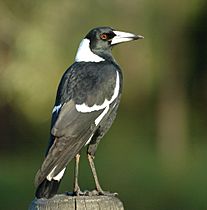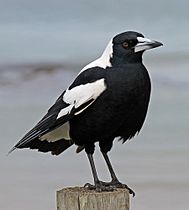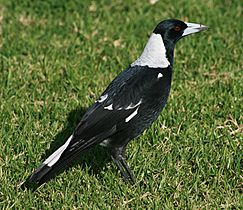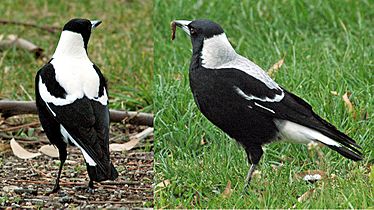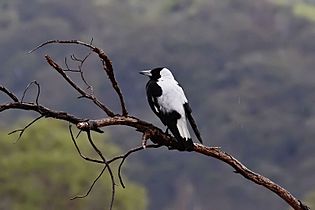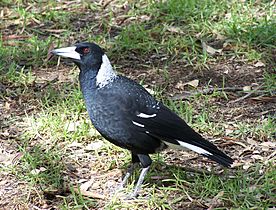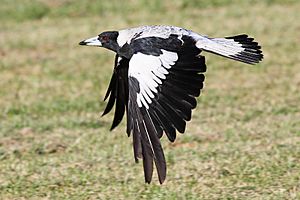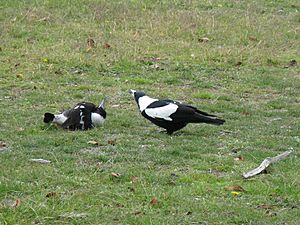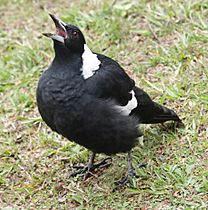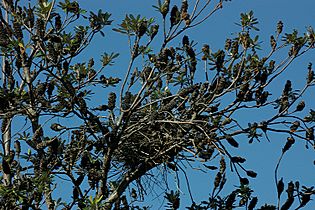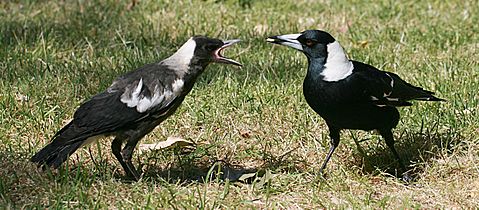Australian magpie facts for kids
Quick facts for kids Australian magpie |
|
|---|---|
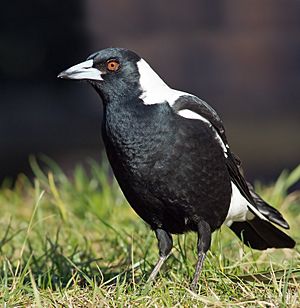 |
|
| G. tibicen hypoleuca, Tasmania | |
| Conservation status | |
| Scientific classification | |
| Genus: |
Gymnorhina
|
| Species: |
tibicen
|
| Subspecies | |
|
9, see text |
|
 |
|
| Natural range | |
| Synonyms | |
|
Cracticus tibicen |
|
The Australian magpie (Gymnorhina tibicen) is a well-known black and white bird. It is a passerine bird, which means it is a perching bird. You can find it in Australia, New Zealand, and southern New Guinea.
Contents
What's in a Name?
The Australian magpie was first written about by a scientist named John Latham in 1801. Early settlers called it names like piping poller or flute-bird.
The bird got its name because it looks a bit like the European magpie with its black and white feathers. Early settlers often named new animals after ones they knew from Europe. But these two birds are actually not closely related at all! The Australian magpie's closest relative is the black butcherbird.
-
G. tibicen terraereginae, Queensland
Appearance and Features
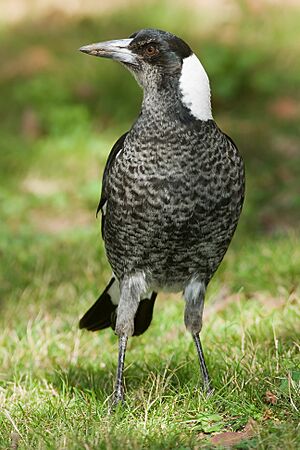
Adult Australian magpies are strong birds. They are about 37 to 43 centimeters (15 to 17 inches) long. They have black and white feathers, gold-brown eyes, and a strong bill that is bluish-white and black.
Males and females look similar. However, you can tell them apart by their back markings. Males have pure white feathers on the back of their heads. Females have white feathers that blend into grey on the back of their heads. Magpies have long legs, so they usually walk on the ground instead of hopping.
Young magpies have dark brownish eyes until they are about two years old. Adult magpies have dull red eyes.
Where They Live
The Australian magpie lives in the Trans-Fly region of southern New Guinea. You can also find them across most of Australia. They are not found at the very tip of Cape York, in the Gibson and Great Sandy Deserts, or in southwest Tasmania.
Magpies like open areas such as grasslands, fields, and places where people live. This includes parks, gardens, golf courses, and streets. They prefer areas with scattered trees or nearby forests. Birds build their nests and find shelter in trees. But they mostly look for food on the ground in these open spaces.
Daily Life and Habits
Australian magpies are mostly active during the day. Sometimes, they might call out at night.
They usually stay in one area and protect their territory. Magpies live in groups that claim a certain area. They have adapted well to living near people. You can often see them in parks, gardens, and farms in Australia and New Guinea.
Amazing Calls and Songs
The Australian magpie is one of Australia's best songbirds. They have many different calls, and some are very complex.
When a magpie is alone, it might make a quiet, musical warbling sound. These songs can last for up to 70 minutes. They are more common after the breeding season ends. Pairs of magpies often sing a loud, musical call called carolling. They do this to show off or protect their territory. When they carol, they tilt their heads back, puff out their chests, and move their wings.
A group of magpies will sing a shorter, repeated carolling song just before sunrise (dawn song) and after sunset (dusk song). This happens in winter and spring.
Magpies also use beak-clapping to warn other birds. They have high-pitched alarm calls when they see dangers like eagles or monitor lizards.
Their calls can change pitch a lot, sometimes as much as four octaves. Magpies can copy the sounds of over 35 different bird species. They can also mimic dogs, horses, and even human speech! They have even been heard copying the sounds of emergency vehicles during bushfires.
Their complex, musical call is one of the most famous sounds in Australia. In a poem, the magpie's call is described as quardle oodle ardle wardle doodle.
Reproduction and Life Cycle
Magpies usually start breeding when they are between three and five years old.
They have a long breeding season. In northern Australia, they breed from June to September. In cooler areas, they start in August or September and might continue until January.
The nest is shaped like a bowl. It is made of sticks and lined with soft materials like grass and bark. Near people, they might use man-made materials. Only female magpies build the nests. Nests are usually high up in a tree fork. They often use eucalypt trees, but also pines and elms. The channel-billed cuckoo is a bird that lays its eggs in magpie nests. Magpies will raise the cuckoo chicks, which then push out the magpie's own young.
Australian magpies lay two to five light blue or greenish eggs. The eggs are oval and about 30 by 40 millimeters (1.2 by 1.6 inches). Chicks are born pink, naked, and blind. Their eyes open fully around 10 days old. They grow soft downy feathers in the first week. Their black and white colors appear early on. The female usually feeds the nestlings, but the male magpie will feed his partner.
Male magpies also help feed the young birds. Magpies are known for cooperative breeding. This means other birds in the group help feed and raise the young. This can depend on the region and the group size.
Young magpies start finding their own food three weeks after leaving the nest. By six months old, they mostly feed themselves. Some young birds beg for food until they are eight or nine months old, but adults usually ignore them. Birds reach their adult size by their first year. Many leave their family group around one year old, but some stay until they are four.
-
Nest in a banksia tree
What They Eat
Australian magpies eat many different things, so they are omnivores. Their diet is mostly made up of small creatures without backbones. This includes earthworms, millipedes, snails, spiders, and scorpions. They also eat many kinds of insects like cockroaches, ants, beetles, and cicadas. They can even catch large grasshoppers while flying.
Sometimes, they eat small animals like skinks, frogs, and mice. They also eat grains, tubers, figs, and walnuts. Many people feed magpies in their backyards.
Magpies use their bills to poke into the ground or flip over things to find food. They swallow smaller prey whole. But they rub off the stingers of bees and wasps before eating them. They also remove irritating hairs from caterpillars.
-
With a cicada at Church Point.
Dangers and Predators
Natural predators of magpies include different types of monitor lizards and the barking owl. Sadly, many magpies are hit by cars or get shocked by power lines. They can also be poisoned if they eat other animals that have been targeted with bait, like mice or rats. The Australian raven might take baby magpies if they are left alone in the nest.
Magpies in Other Countries
Over 1000 Australian magpies were brought to New Zealand between 1864 and 1874. Now, they are sometimes seen as a pest there. People think they might be taking over areas where native New Zealand birds like the tūī and kererū used to live. Magpies sometimes raid nests for eggs and young birds. Magpies were also introduced to the Solomon Islands and Fiji. In those places, they are not considered a problem.
Why Magpies Swoop
Magpies live in cities and towns all over Australia. They are used to being around people. However, a small number of magpies (less than 9%) can become very protective during breeding season. This is when they have their nests and young chicks.
Almost all magpies that swoop (about 99%) are male. They usually swoop pedestrians (people walking) when they are about 50 meters (164 feet) from their nest. They might swoop cyclists (people on bikes) from about 100 meters (328 feet) away.
Some people believe that if a magpie sees a human trying to help a chick that has fallen from its nest, the bird might think this is a threat. This could make the magpie more aggressive towards humans later on.
Magpie swooping happens in most parts of Australia. However, magpies in Tasmania are much less aggressive than those on the mainland. Swooping can sometimes cause minor injuries, usually to the head. If a cyclist is unexpectedly swooped, they might lose control of their bike, which could lead to an accident.
Sometimes, a bird might dive down and hit a person's head with its chest. Very rarely, a magpie might land on the ground in front of someone, then jump up and land on their chest, pecking at their face or eyes.
To avoid being swooped, it's best not to walk too close to a magpie's nest during breeding season. If you must, an umbrella, a helmet, and sunglasses can help protect you. Cyclists can put a long pole with a flag on their bike. Many cyclists also attach cable ties to their helmets, which seems to help keep magpies away.
-
A magpie defending its territory from a brown goshawk
Cool Facts About the Australian Magpie
- The Australian magpie is most closely related to the black butcherbird. It is not related to the European magpie, which is a different type of bird.
- Its scientific name, Gymnorhina tibicen, comes from the Latin word tibicen, meaning "flute-player". This refers to the bird's beautiful, musical call.
- There are thought to be nine different types (subspecies) of the Australian magpie.
- In spring (and sometimes in autumn), a small number of male magpies become aggressive. They swoop and attack people who come too close to their nests.
- Studies have shown that magpies can recognize at least 100 different people! They might be less likely to swoop people they know and are friendly with.
- Australian magpies usually live for about 25 years. Some have even lived up to 30 years!
- The Australian magpie is a mascot for many sports teams in Australia and New Zealand. These include the Collingwood Magpies and the Hawke's Bay Magpies.
- Magpies are a protected native species in Australia. This means it is against the law to kill or harm them.
See also
 In Spanish: Verdugo flautista para niños
In Spanish: Verdugo flautista para niños



